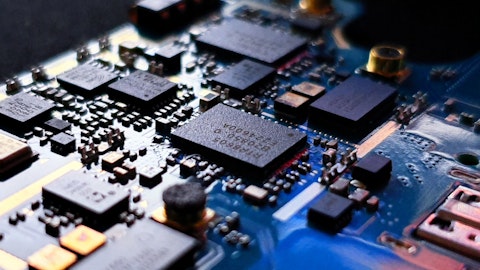So, the routers right now we’ve seen about a 30% pullback, I’d say that’s largely industry-wide. I would expect that recovery to bounce back a little bit from that — from that base, but certainly not be what it was the previous — the previous year. If you go back a little over a year, those numbers were a little bit elevated in a frothy buying season, and the modules that has fluctuated quite a bit. We’d probably put it somewhere around $260 million or so on a normalized basis and with some potential upside, we look at it about $390 million – $370 million upside opportunity in North America, but we don’t expect to get 100% of that business. So we’ll be pursuing that rather aggressively. It will take some time for us to realize that and we would probably look to deliver those in two years out.
Tristan Gerra: Great, very useful. And then from a follow-up question, so you mentioned making private network adoption much easier as an opportunity for LoRa, is that really 100% of your focus on LoRa right now, as it sounds like the bulk of the inventory correction associated with helium is behind. The feedback notably from the Things Conference is that there is basically much easier access to lower implementation than just a few years ago with a fairly clear path of kind of a one to two year ROI for customers who want to implement LoRa. So could you expand a little bit on what you think is still holding LoRa at a revenue run rate that admittedly is lower than the prior management team was guiding for a few years ago and any elaboration on where you see opportunities to improve the adoption?
Paul Pickle: Yeah, I will say this, and I think the execution in LoRa is pretty good, let’s say below expectations that were set by prior management but I still think anytime you grow a business from zero to $100 million in four years in semiconductor land that’s usually pretty special. So, it’s a unique technology. Obviously, it’s a technology that the market is there ready to adopt. When you start bringing together a large ecosystem set of partners that all have to work together to drive the solution, it definitely is going to slow down, but as we look at adoption, it continues to pick up. There’s a little bit of a blip in there in terms of helium gateways that maybe was a contributor to the numbers being a little bit larger than what actual market adoption showed, so during that frothy buying season.
But I still look at it as good steady adoption. Overall the market needs something that’s easy to implement. If we talk to customers that are looking for something that’s lower base, they’re not necessarily in IoT, they’re not necessarily somebody that has the breadth of R&D in order to implement something from womb to tomb. So this is where we have done taken initiatives in the past in order to make LoRa easier to adopt, we are licensing the technology out in order to further that adoption and we’ll continue to evolve and deliver to the market tools necessary to speed up that adoption. But I do think that there is a couple holes in the delivery of that that solution that we could fortify in order to speed things up.
Tristan Gerra: Great. Thank you very much.
Operator: And the next question comes from the line of Christopher Rolland with Susquehanna. Please proceed.
Christopher Rolland: Hi, guys, just a quick follow-up, the amount of turns business you guys expect to get to guidance in the quarter, POS trends.
Paul Pickle: Yeah. Last quarter we were just over 50%, we’re slightly less than that this quarter. It’s not something that we will be tracking and reporting on, but it’s slightly better than it was last quarter.
Christopher Rolland: Thanks so much.
Operator: And the next question comes from the line of Harsh Kumar with Piper Sandler. Please proceed with your question.
Harsh Kumar: Yeah, hey guys, thanks for sliding me in. Quick question, Mark. So in the analog space in the industry, we’re seeing a variety of companies basically all of them start to guide down, I guess, looking at your results, you’re faring much better. My question to you is, why is that — is that a function of data center offsetting a lot of your traditional analog businesses or is it because you started the correction earlier or is there something else going on that is perhaps helping you do better?
Mark Lin: Yeah. It’s both. I’ll have Paul, he provided a lot of color on the end markets and for data center. But it is, we did sort of guide down before our peers in that group. So, I think that’s another big portion of why we’re cutting down from 200 to 190.
Paul Pickle: Yeah, I think I’ve said it in a set of investor meetings at one time, the bane of our existence as an operations team that’s really good. So when we got all the orders, our team had been able to secure the capacity and deliver on it. And I’m saying that, of course, tongue in cheek, they’re phenomenal, predominantly efficient team, but we did — we were able to secure that capacity and delivered as a result we shipped it all and saw the correction a little bit early. As a result, we’re seeing the rebound a little bit early, but we are getting helped out with a couple of key markets, where we do have beachheads, one surprisingly enough is TVS, where we continue to innovate on the next-generation interfaces, we got some of the best specs out there. And yes, you do kind of share this with competition over time. But right now we’re the only guy who can deliver and we’re seeing upside as a result and AI is just a gift, it’s phenomenal SAM expansion.
Harsh Kumar: So on that — on the AI stuff, can I ask you if your visibility is extremely solid, in other words you, are you seeing orders just pile up and for multiple quarters visibility or is it a situation where of course you’re hand to mouth, but the orders are coming in, kind of spurts of a quarter.




